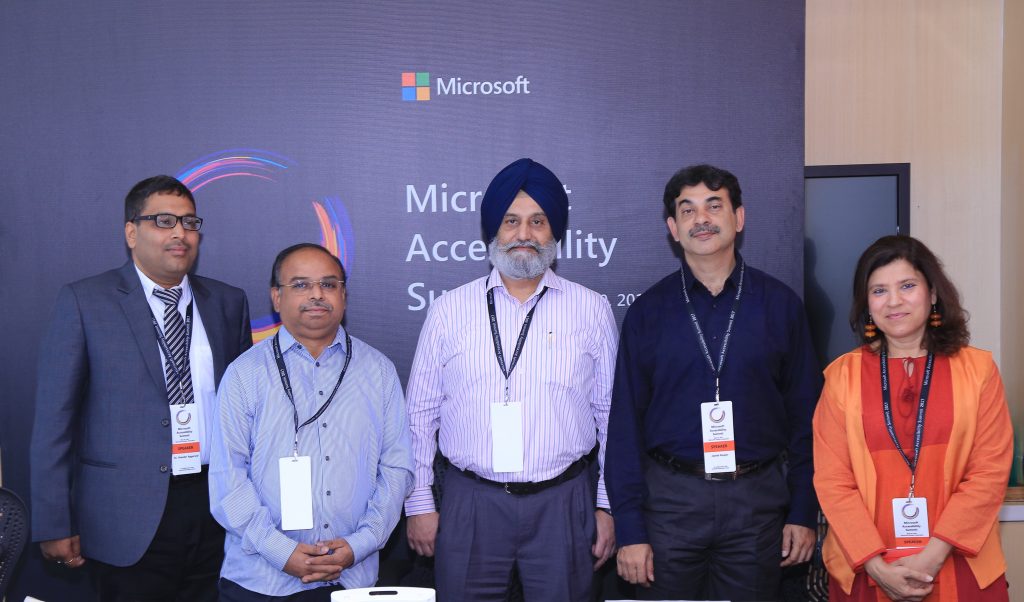
Hyderabad, 30 May 2017: Microsoft India today hosted its first-ever Accessibility Summit (#ThinkAccessAbility) in the country to enhance technology access for people with disabilities. The summit aimed at demonstrating the business value of accessible technology for organizations, the need for a collaborative effort as well as assessing policy’s role in creating an accessible India. The summit brought together leaders from the government, non-profit organizations, filmmakers, entrepreneurs and budding technologists to present their views and best practices around accessibility and technology’s potential in aiding inclusion.
Shri Navreet Kang, Secretary, Department of Empowerment of Persons with Disabilities, Ministry of Social Justice and Empowerment, Government of India said, “We believe that inclusion of persons with disabilities is imperative for India’s growth. It is therefore, critical that we empower them with equal access and opportunity. We look forward to public-private partnerships that can enable better social inclusion and help people with disabilities achieve more.”
Speaking at the summit, Shri Jayesh Ranjan, IT Secretary, Department of IT, Electronics & Communication, Government of Telangana said, “Our vision is to ensure that persons with diverse abilities have equal access to the physical environment, transportation, information and communication technologies, and to other facilities and services. The Microsoft Accessibility Summit provides an ideal platform to bring together policymakers and influencers to understand the policy environment and chart a direction for making life, experiences and opportunities accessible to all.”
A platform to discuss, imagine and bring new perspectives for innovative use of technology
Through a series of constructive sessions, the conference focused on the role of technology in creating accessible businesses, scalable and sustainable models for skilling youth with disability. It also examined how assistive technologies can help in treating Autism Spectrum Disorders and Special Learning Disabilities (SLD). There was a special focus on the need for regulatory policies for innovation on accessible technologies and inclusive hiring practices. These interactions also provided insights into regulations, specifications and standards in terms of accessibility along with an understanding of optimization of existing hardware and software configuration to drive accessibility. Shri M. Jagadeeshwar, IAS, Department of Women and Child Development, Government of Telangana also contributed to the discussions as part of the summit.
Technology innovations for driving accessibility
The summit featured unique technology-based projects that empower people with disabilities. These included innovations from non-profit organizations, assistive technologies developed by Microsoft partners as well as Microsoft solutions. A young team of three students from IIT Kharagpur showcased White Cane, a personal assistant device for the visually impaired, which they have developed as part of Microsoft Imagine Cup.According to Dr. Jitender Aggarwal, Founder & CEO Sarthak Educational Trust, “Accessibility is one of the dire necessities for creating an inclusive environment. The difference between the able bodied and disabled is not so much because of physical challenges, as due to the fact that everything around us is designed from the perspective of able bodied people only. In such a scenario, accessible and adaptive technologies act as a support system to promote inclusion and empowerment of persons with disabilities.”
Speaking at the conference, Madhu Khatri, Associate General Counsel and Accessibility Lead, Microsoft India said, “At Microsoft we believe there are no limits to what people can achieve when technology reflects the diversity of everyone who uses it. We are committed to transparency, accountability, and inclusion in our products and our culture, and we are deeply inspired by the opportunity to work with others around the world to explore what’s possible. A market-driven ecosystem is the best environment for encouraging greater accessibility for all users. The Summit is a significant step forward in advancing our efforts towards sensitizing stakeholders and partners on the need for the business and social value of accessibility.”
Please find more information to Microsoft’s approach to accessibility on Microsoft Accessibility Website and see Microsoft India’s video on Empowering for Inclusion.
About Microsoft India
Founded in 1975, Microsoft (Nasdaq “MSFT” @microsoft) is the leading platform and productivity company for the mobile-first, cloud-first world, and its mission is to empower every person and every organization on the planet to achieve more. Microsoft set up its India operations in 1990. Today, Microsoft entities in India have over 8,000 employees, engaged in sales and marketing, research and development and customer services and support, across 11 Indian cities – Ahmedabad, Bangalore, Chennai, New Delhi, Gurugram, Noida, Hyderabad, Kochi, Kolkata, Mumbai and Pune. Microsoft offers its global cloud services from local datacenters to accelerate digital transformation across Indian start-ups, businesses, and government agencies. In 2016, Microsoft opened one of its eight Cyber Security Engagement Centers in the country, to address security needs of both public and private sectors.






